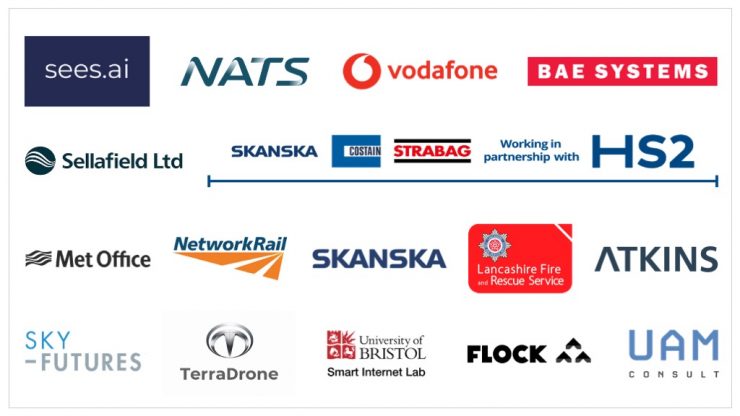A consortium of 16 entities led by specialist drone command & control solution developer, sees.ai, including NATS, BAE Systems, Terra Drone and Sky-Futures, has won a share of GBP30 million to develop and test a remotely operated drone system for industrial and urban environments.
The funding comes from the Future Flight Challenge, Phase 2 competition, part of the Industrial Strategy Challenge Fund, delivered by UK Research and Innovation.
The futuristic system will enable remote inspection and monitoring of industrial sites e.g. nuclear, construction and oil & gas, urban sites in the public domain e.g. road & rail and telecoms infrastructure and live emergency services support.
The system, which uses similar technology to autonomous cars, enables highly automated drones to be flown under tight human supervision by pilots based in a central control room hundreds of miles away. Pilots can precisely execute complex missions remotely – even reactive missions (designed on-the-fly) and close-quarter missions encountering GPS-denial, magnetic interference and degradation & loss of comms.
Congested area operations are very challenging, but the potential reward for unlocking these types of mission in terms of public health & safety, cost efficiency and environmental impact is huge. No single entity could make this happen alone, so this consortium of aviation, aerospace, industrial and emergency service giants, together with sees.ai has joined forces to advance the system and integrate it into the wider aviation ecosystem.
Technical contributors to the consortium are: NATS, Vodafone, BAE Systems, The Met Office, Flock Cover, UAM Consult Ltd and University of Bristol Smart Internet Lab.
The project involves the system being put through a series of tests, increasing in complexity and challenge, with end-client organisations: Skanska; Skanska Costain STRABAG working in partnership with HS2; Sellafield; Lancashire Fire and Rescue Service; Vodafone; Network Rail; and Atkins. During these tests the system will be operated by two of the world’s leading drone service providers, Terra Drone and Sky-Futures or by the in-house drone teams at Sellafield, Network Rail, and Lancashire Fire and Rescue Service.
Louisa Smith, Head of R&D at NATS said: “Drones represent an exciting development and offer new opportunities for emergency services, businesses and individuals across the globe. At NATS, we want to deliver a system which ensures all airspace users can operate safely alongside each other. This Future Flight project will enable us to further develop capabilities by collaborating with partners that will future-proof our systems to provide safe and secure services for everyone who wants to fly any type of aircraft in our skies.”
Anne Sheehan, Business Director, Vodafone UK said: “For drones to deliver on their huge potential in business, we have to reduce the reliance on people – we have to enable safe and managed flights without the dependence on the traditional piloted approach. With our technology, we can play a crucial role in that and we’re looking forward to working with our partners to develop this vital capability.”
John McKenna, CEO of sees.ai said: “The Future Flight Challenge funding will accelerate us towards a future where drones fly autonomously at scale – high up alongside manned aviation and low down inside our industrial sites, suburbs and cities. Unlocking the safe and remote operation of drones in urban and industrial locations will deliver huge benefits to society across public health & safety, efficiency and environmental impact. We are enormously proud to be leading this consortium and to be working with such incredible partners to develop this advanced Beyond Visual Line of Sight (BVLOS) aviation system.”
For more information visit:




